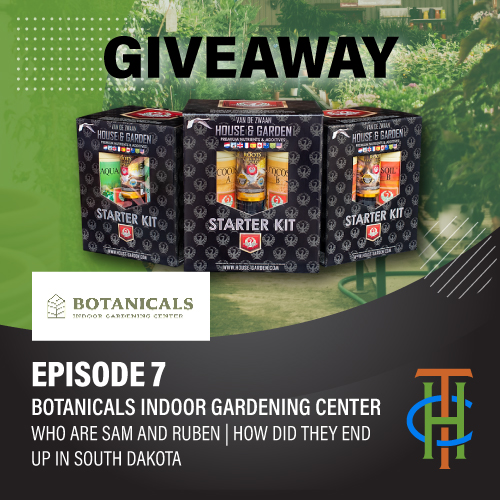
In Episode 7 of The Coughy House Podcast, we sit back down with Sam and Ruben at Botanicals Indoor Gardening Center to ask who they are and how they ended up in South Dakota.
Sam and Ruben, are truly a match made in South Dakota. Their chemistry and friendly demeanors give you the impression that they’ve known each other and been friends for years. But, in fact, they are from opposite sides of the country, come from totally different backgrounds, and had never met prior to moving to South Dakota. Luckily for us, both Sam and Ruben were handpicked by the ownership of Botanicals to fill the positions that they hold.
Whether through self-education or learning from mentors, both Sam and Ruben have put in years and years of hard work to acquire the growing expertise that they have. As individuals both Sam and Ruben are expert growers but together, they bring a wealth of much-needed knowledge and expertise to the industry. Their combined expertise is crucial in ensuring that the state’s cannabis industry continues to thrive and evolve.
The good news is that they both love it in South Dakota and don’t plan on leaving us anytime soon.
Visit Botanicals Indoor Gardening Center Online at botanicalsigc.com

The 1:1 THC: CBD ratio means that your cannabis product contains (ideally) an equal amount of tetrahydrocannabinol (THC) and cannabidiol (CBD). These are the two main chemical compounds or cannabinoids in the cannabis plant.
Anecdotal evidence indicates that this equally distributed ratio is optimal for experiencing the benefits of cannabis. This combination of cannabinoids is often called the “Golden Ratio.” Together, these two cannabinoids are considered by some to be more powerful anti-inflammatories than alone, in what is called the entourage effect.
Cannabis products containing only THC could be helpful for people experiencing nausea and vomiting. The anti-nausea drug dronabinol (brand name Marinol) is a synthetic form of THC and is prescribed to treat chemotherapy-induced nausea. THC-only products have also been reported to relieve pain and reduce muscle spasms. A THC-only product can be quite psychoactive.
The benefits of using a CBD-only product include a potential reduction in anxiety and improved sleep patterns. Some people prefer CBD-exclusive products simply because they don’t want THC’s intoxicating effects. (It should be remembered that CBD is technically psychoactive.)
The ratio of 10:1 tips the see-saw towards CBD, which some may find dampens THC’s psychoactivity. However, sedation is still possible in higher doses. The ratio of 20:1 CBD:THC may produce similar sedative effects.
Other CBD-rich ratios like 3:1 or 6:1 may tip the scale in favor of CBD’s effects.
These products contain both THC and CBD, but this time with more THC. The CBD can buffer some of THC’s psychoactivity in such products but may also lengthen the experience.
High-CBD-low-THC ratios are recommended for cannabis novices who don’t know how their bodies and brains will react to THC.
The “entourage effect” refers to the mixture of compounds in cannabis that work together synergistically to modulate the plant’s psychoactive effects. Some suggest that the mix of compounds also improves the health benefits of various cannabinoids.
There are hundreds if not thousands of compounds in the cannabis plant. Of these, three main groups of compounds contribute towards the entourage effect. These are:
Terpenes are organic chemical compounds that naturally occur in the cannabis plant. They are found in the trichomes (tiny hairs protecting the outer layer of the plant) and give cannabis its distinctive smell and flavors. They are mostly associated with cannabis, but terpenes are found in other plants, including herbs like thyme and citrus fruits like lemons.
These organic compounds do much more than deliver a potent flavorful, aromatic experience when consuming cannabis. Research indicates that terpenes may be beneficial to treat wide-ranging health conditions, from epilepsy to malaria.
First, flavonoids are essential for numerous plant functions, including reproduction and ultraviolet (UV) filtration. These key compounds also act as chemical messengers and physiological regulators. In short: flavonoids are essential for the plant’s survival and reproduction.
Beyond their role in the life cycle of a plant, flavonoids offer wide-ranging health benefits for people.
Each flavonoid offers health benefits, but these are some of the most common therapeutic uses for flavonoids:
A system of cannabinoid receptors, lipids, and enzymes that performs a large role in maintaining homeostasis, or internal regulatory balance, in many bodily functions. All mammalian vertebrates have an endocannabinoid system, which interacts with endocannabinoids and phytocannabinoids that are found in cannabis. The endocannabinoid system’s far-reaching influence is what allows cannabis to provide medicinal benefits for a large range of symptoms.
Cannabinoid receptors sit on the surface of cells and “listen” to conditions outside the cell. They transmit information about changing conditions to the inside, kick-starting the appropriate cellular response. There are two major cannabinoid receptors: CB1 and CB2. These aren’t the only cannabinoid receptors, but they were the first ones discovered and remain the best-studied.